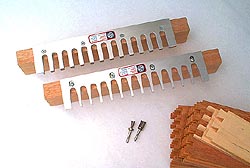Home - This Old Workshop
Keller 1601 Professional Dovetail Jig
Keller 1601 Professional Dovetail Jig

Some of the best things in woodworking are old ideas and this is true of most hand tools and how to use them. The art has often gone backwards and has struggled to retain its high level of impressive artisanship from the past. However in the world of power tools, the reverse is mostly true. The world is full of cheap crappy tools lacking in performance, quality and safety, but better tools are out there also. If a guy wants to buy a great tool today, fences, motors and safety aregenerally a vast improvement to the past andmost are better engineered,but some new tools are simply junk while others are far superior to yesterday’s best. So buyer be ware.
Now going back about forty some years to 1976 a woodworker named David Keller developed aningenious little jig for cutting dovetails with a router. The Jig is only for through dovetails but it’s elegantly simple. The Keller Dovetail jig was revolutionary and has earned a place in my shop. Even though I have jigs that are more versatile and that will do half blind, blind and sliding dovetails,the Keller Jigs key feature is ease of use, repeatable quality and speed that are unmatched by any other Dovetail Jig, and its been this way since 1976. I have had the Keller 1601 in my shop since 1995 and use it every single week. I mostly use it to make my drawer boxes and other boxes. The Keller 1601 is simple and sometimes simple is the best way to go. Another use for the Keller system is for box joints, capable of producing some of the best box joints that can be made and they are faster than doing it on the table saw.
Here is how the system works: There are two 16 inch templates that are each screwed to shop supplied backer boards. You simply clamp the project tails board to the backer board with the template positioned over the end grain. Set the dovetail bit depth deep enough to accommodate the thickness of the adjoining “pins”board. You can either put the board in a vise and rout or you can flip the board over and use your router table to rout the tails. Once your done routing all your tails you switch bits and templates. The second part is so easy,you just mount the pins board vertically in your vise, place the tails board you just cut over the end of the pins board with the tails over the end grain of the pins board and scribe one of the tails into the end grain with a marking knife. Line up the pins template exactly over the scribe marks and clamp the project board to the backer board. Set the straight pattern bit depth deep enough to accommodate the tails board thickness and rout out the waste.
Be sure to check out the new video below on the Keller Dovetail Jig and its use so you can see how simple this jig is to use. This timeless idea is simply the best for ease of use, accuracy, no test cuts, no wasted materials and an extremely easy learning curve. Two manufacturersusing this system are Keller and the WoodRat, so it’s not a surprise they are two of my favorite jigs. The first time I used the Keller Dovetail jig was in 1977 in high school woodshop. Mr. Davi introduced the Keller and said it was a game changer that would enable the small shop to compete with the commercial shop. Mr. Davi was right, you can get the look of hand cut dovetails in a fraction of the time. At under $300 the Keller 1601 and a full set of bits is all the small shop needs to compete with the big shop. Once set up and ready to go with all the blanks you can do close to 25 drawer boxes in one hour which would not be a bad days work. I give the Keller 4.5 stars out of 5 The only downfall to this jig is its fixed spacing which you can play with a bit if you work at it
Lance Granum




















